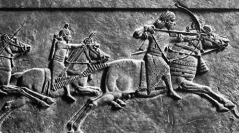

 Anthropozoologica
58 (6) - Pages 73-84
Anthropozoologica
58 (6) - Pages 73-84Following the studies carried out by Pauline Albenda or Elena Cassin on the human-animal relationship through the figures of the horse (Equus caballus Linnaeus, 1758) and the lion (Panthera leo Linnaeus, 1758), this study specifically questions the facial features of these two animals as well as that of the human face under the reign of Ashurbanipal (669-631/627 BC). The corpus of the study consists of the lion hunting scenes uncovered in rooms C, S and S1 of the Northern Palace of Nineveh. Marked by the action’s violence, these hunting scenes show enraged lions, roaring or rumbling, wounded by numerous arrows. In front of them stands the monarch, unmoved. How can we understand this absence of human emotion and the displacement of the expression of passions to the animal figure? The encounter between the king and the lion seems to be crystallized here around a face-to-face encounter that, by breaking down the masks, reveals the faces of two equals.
Human, Assyria, art history, hunt, emotion.